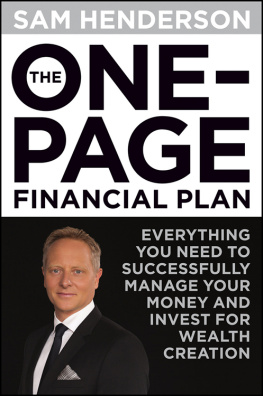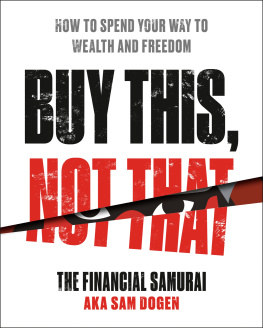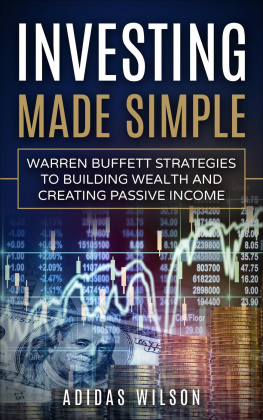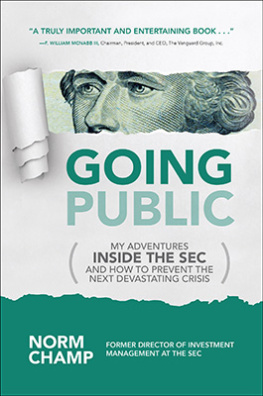

Copyright 2013 by Sanford C. Botkin and Matthew I. Botkin. All rights reserved. Except as permitted under the United States Copyright Act of 1976, no part of this publication may be reproduced or distributed in any form or by any means, or stored in a database or retrieval system, without the prior written permission of the publisher.
ISBN: 978-0-07-179851-8
MHID: 0-07-179851-X
The material in this eBook also appears in the print version of this title: ISBN: 978-0-07-179850-1, MHID: 0-07-179850-1.
All trademarks are trademarks of their respective owners. Rather than put a trademark symbol after every occurrence of a trademarked name, we use names in an editorial fashion only, and to the benefit of the trademark owner, with no intention of infringement of the trademark. Where such designations appear in this book, they have been printed with initial caps.
McGraw-Hill eBooks are available at special quantity discounts to use as premiums and sales promotions, or for use in corporate training programs. To contact a representative please e-mail us at bulksales@mcgraw-hill.com.
This publication is designed to provide accurate and authoritative information in regard to the subject matter covered. It is sold with the understanding that neither the author nor the publisher is engaged in rendering legal, accounting, securities trading, or other professional services. If legal advice or other expert assistance is required, the services of a competent professional person should be sought.
From a Declaration of Principles Jointly Adopted by a Committee of the American Bar Association and a Committee of Publishers and Associations
Note: This publication is based on the expertise of the authors and experts who have been interviewed and have reviewed the chapters. Since everyones situation is different and since laws change over time, nothing in this book should be construed as an accounting or legal opinion. You should check with a financial professional before implementing the strategies noted in this publication.
TERMS OF USE
This is a copyrighted work and The McGraw-Hill Companies, Inc. (McGraw-Hill) and its licensors reserve all rights in and to the work. Use of this work is subject to these terms. Except as permitted under the Copyright Act of 1976 and the right to store and retrieve one copy of the work, you may not decompile, disassemble, reverse engineer, reproduce, modify, create derivative works based upon, transmit, distribute, disseminate, sell, publish or sublicense the work or any part of it without McGraw-Hills prior consent. You may use the work for your own noncommercial and personal use; any other use of the work is strictly prohibited. Your right to use the work may be terminated if you fail to comply with these terms.
THE WORK IS PROVIDED AS IS. McGRAW-HILL AND ITS LICENSORS MAKE NO GUARANTEES OR WARRANTIES AS TO THE ACCURACY, ADEQUACY OR COMPLETENESS OF OR RESULTS TO BE OBTAINED FROM USING THE WORK, INCLUDING ANY INFORMATION THAT CAN BE ACCESSED THROUGH THE WORK VIA HYPERLINK OR OTHERWISE, AND EXPRESSLY DISCLAIM ANY WARRANTY, EXPRESS OR IMPLIED, INCLUDING BUT NOT LIMITED TO IMPLIED WARRANTIES OF MERCHANTABILITY OR FITNESS FOR A PARTICULAR PURPOSE. McGraw-Hill and its licensors do not warrant or guarantee that the functions contained in the work will meet your requirements or that its operation will be uninterrupted or error free. Neither McGraw-Hill nor its licensors shall be liable to you or anyone else for any inaccuracy, error or omission, regardless of cause, in the work or for any damages resulting therefrom. McGraw-Hill has no responsibility for the content of any information accessed through the work. Under no circumstances shall McGraw-Hill and/or its licensors be liable for any indirect, incidental, special, punitive, consequential or similar damages that result from the use of or inability to use the work, even if any of them has been advised of the possibility of such damages. This limitation of liability shall apply to any claim or cause whatsoever whether such claim or cause arises in contract, tort or otherwise.
To my wife, Lori, for her endless patience and for her great feedback
S. B.
Acknowledgments
We would like to dedicate this work to all the wonderfully talented people who participated in this book, including the financial writers and multimillionaires who gave their time and shared their knowledge with me, many of whom didnt want to be specifically identified.
We especially want to thank Keith Cunningham for his significant contribution to , Getting Out of Debt Forever. He is allegedly the Rich Dad in Robert Kiyosakis book Rich Dad Poor Dad. Cunningham is the author of the Keys to the Vault: Lessons from the Pros on Raising Money and Igniting Your Business.
We also want to thank Jeff Sella, CPA, CFP, and the owner of SPC Financial, for his numerous contributions, suggestions, and edits made in of this book.
We also want to thank Alan Williams and Peter Jepson from Money Mastery for providing some great suggestions regarding savings and retirement planning.
We also wish to thank Jennifer Ashkenazy, our editor at McGraw-Hill, for her input and timely suggestions as well as Jane Palmieri for her editorial input.
We also want to thank you, our wonderful readers, for your desire to improve your life when you bought this book. We wont let you down!
Introduction
When a person of money meets a person with experience, the person with the experience will get some money, and the person of money will get some experience.
Harvey Mackay, Swim with the Sharks Without Being Eaten Alive
The Beginning of the Beginning
This book is about moneynamely, your money, or the possible lack of it. My goal is to make you the person of experience so you can become both the person of money and the person of experience.
The idea for it started innocently enough with a complaint from my legal book sales representative. We were having some small conversation about life when he also noted that his father had some form of dementia. When he tried to find some information about how to obtain support for evaluations for his fathers condition and how to evaluate various types of nursing and independent-living facilities, most of it was in legalese. And he had numerous other financial issues about insurance, mortgages, investment alternatives, and college funding strategies for which he also couldnt find any clear answers.
His main complaint was that almost all of the financial books written were by people who had a bias such as wanting to sell more insurance or wanting to attract more clients or even simply wanting to sell other books that they had previously written. Even worse, some of the information was just outright wrong in his opinion. He cited a guy who had a bestselling book on forming foreign trusts in order to avoid taxes. That same guy had been recently indicted for fraud! He also felt that there were few financial books that were clearly written, comprehensive, and practical for baby boomers and generation Xers.
At first, I thought he didnt research the topics enough. However, when I started conducting my own research, I realized that he was right! Many books clearly had biased or wrong information. Some books were just too elementary or were too complicated. One scam artist was a writer who promoted whole life insurance for everything and anything. Another famous bestselling author had written books whose main goal was to simply sell other books that he had written. Essentially, each book was simply a marketing piece for his other books. The content found in most of his works was either outright wrong or just plainly nonexistent.
Next page









